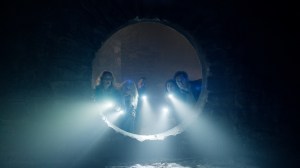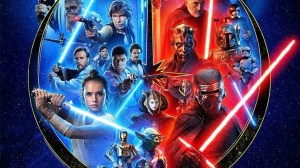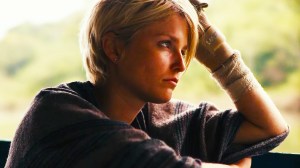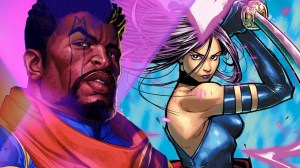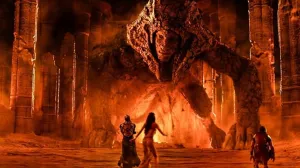The third season of Star Trek: Lower Decks has come to its end with the season finale episode, “The Stars at Night.” The Texas-class ships are neutralized, Mariner has returned home, and Shax got to eject the warp core. It’s been an eventful season for Lower Decks. The final two episodes dug into professional rivalry in Starfleet in a way that Star Trek rarely does, perhaps explaining why so many Starfleet admirals seem to turn into villains. It also paid a visit to to check in with fan-favorite characters Kira and Quark and brought back the Breen for a surprise in an episode.
Videos by ComicBook.com
So what’s next? ComicBook.com had the opportunity to speak to Star Trek: Lower Decks creator/showrunner Mike McMahan about Season 3 following the finale, and touched on how he plans to continue into Season 4. Here’s what he had to say:

One of the things that interested me about these last two episodes was how much they dug into professional pressure and professional rivalry within Starfleet, which isn’t necessarily a thing you see a whole lot of in the other shows. Can you talk about what the discussion around that in the writers’ room was?
Mike McMahan: Lower Decks itself is about not the best ship in the fleet. That’s pretty clear. And all the other shows have their thing. Obviously, the Enterprise is a centerpiece. Deep Space Nine is doing its own thing over near Bajor and the wormhole. Discovery has its own thing going on. Voyager is stuck.
Our show is about Star Trek if you aren’t the best of the best in the fleet, even if you are in this great, idealized, futuristic part of the Federation, of Starfleet. We talk a lot about stories about people working at Google, or Pixar from a creative point of view, where you get to be the best of the best. And then it’s like, “Well, wait, where do I go from here?” And this is, “Wait, if I’m already a captain of a Starfleet ship, is there something better?”
I think about Riker turning down positions or the Starfleet stories that we’ve heard about people who have captained or been on other ships and then they’ve moved up in rank and they’ve turned down admiralties and that kind of stuff. There’s always been an unspoken hierarchy in Star Trek about who’s on the best ships, who’s doing this and that, and sometimes people aren’t always on them, and these are stories about that. This is a fleet of ships that some people are proud to be on, and some people see it as the ship they have to serve on before they move on, but it is a part of Starfleet. This is a story, in the last couple of episodes, about perception, about seeing where you are and deciding that, “Hey, maybe this is the place for me. Maybe I love this. Maybe I can be the best of the California class instead of seeing it as a stepping stone, but that’s totally fine.”
I see people in creative roles all the time that are always so stressed; they want to do the next thing. And sometimes other people are like, “Actually, this rules. I love doing this.” I’m always jealous of those people who aren’t constantly looking for the next leap forward that have found this happy way of being, and those are the stories we’re telling.
I mentioned this to Dawnn Lewis last week too, but it kind of makes even more sense in the Star Trek, Federation society, right? Where there’s no money and so reputation and stature are the closest things you have to currency.
Yeah, but it’s not only that. It’s, what kind of science do you want to be doing? What kind of gigs are you getting assigned? There might not be any money in Starfleet, but if you look at academics, there’s a lot of competition between different scientists over who’s getting to do what and who has what resources.
And then, even in Star Trek, you’re seeing that stuff. When the Defiant came on Deep Space Nine, they had not as good replicators. They’re sleeping in bunks. It’s all energy usage and energy consumption and who has access to what replicator codes, and all of these different kinds of things that have always been in the margins of Star Trek. It’s little moments, but Lower Decks has always lived in the B stories of Star Trek. It’s going back to planets that we’ve only been to once or seeing bad guys, aliens, that we’ve only seen once, or talking about these little things that were offhand-mentioned and making them a bigger thing.
How much of this was also just about explaining the trope where otherwise presumably good Starfleet officers suddenly become supervillains when they become admirals? Because that seemed to happen a lot.
Yeah, yeah, I know, I was talking about that today. I wonder if when you become an admiral, do you sit yourself down and go, “Okay, don’t be a bad admiral. Don’t do it. It’s going to be testing.” Because something has to happen when you’re an admiral where you start going, “You know what? I’m going to go to a ship and I’m going to tell the captain to do whatever the heck I want,” you know? There’s something about being an admiral in Starfleet that makes being bad very tempting. I don’t know what it is. Maybe it’s something in the water they’re drinking.
I was really interested in the fact that Picard is backing the archeological expeditions. Have you worked out a more detailed explanation of what exactly that looks like?
For me, Picard has this love of archeology, and he also had a literal love of Vash at one point, who’s another person on the fringe, in the margins, and gets stuff done. What I think he was doing is that, on the side and quietly, he is making sure that people who appreciate him and who listen to him are giving access to materials, fuel, and stuff to people that aren’t a part of Starfleet, but that are doing good, that Picard trusts, but that might not be doing things like how the Federation Council might fully want them to. But I think Picard has a bit of a sly streak to him, and then he probably sees himself when he was younger in people like Petra and Vash and these rogue archeologists. So he’s doing stuff for fun on the side to make sure that he’s still getting to be participating in that, just with a hand off of the wheel.
I love the big California class rally at the end. Tell me about what the discussion in the writer’s room was about that and also was any of that at all a joke about the somewhat homogenous fleet that shows up at the end of the first season of Star Trek: Picard?
[Laughs] No, no, no. It wasn’t a joke about the end of Picard. Although there are all of those different California-class ships, I actually like that if you freeze-frame it, every single one of those ships has its own paint job. We made sure that every single one of them has a cool thing that sets them apart.
What we were talking about with the ending, in the first season the Cerritos gets saved by the Titan, second season the Cerritos saves another ship, and then third season, I wanted there to be another climactic moment that said something about the California class itself. In some of the very first episodes, you see Capt. Freeman being exonerated and then the Cerritos crew finds out that they thought that they were the joke of the California class, but then they’re finding out that, oh, they’re actually the most popular, they’re the coolest of the California class, which they didn’t know. They didn’t know they’d become the cool kid.
It’s a mirror to Lower Decks where I was like, “Hey look, here’s a brand new Star Trek show that nobody wanted.” And then the trailer came out and all of these people were sighing on YouTube and putting their faces in their hands dramatically until they moved on to the next thing. And slowly, we just kept doing whatever we wanted to do and we found our fans, we found people who loved the show, and it happened without us noticing because we just kept our heads down and did what we wanted to do. So there’s a little bit of that.
And then at the end of the season, I just wanted it to come together and be, look, this California class, it might not be the best and they might not be the coolest, but they come together, they have each other’s backs, they are Starfleet, and getting to see something we don’t usually get to see, seeing all of this one particular type of ship that came and answered the call. That felt really special to me. There is a little bit of a cookie-cutter nature that we were trying to avoid, but it is all one style of ships, and I guarantee you somebody’s going to say, “Aha!” but that was something we were trying to avoid. We were trying to make sure that it felt like a dynamic, cool, surprising moment that gave you something you otherwise wouldn’t have gotten to see.
Do you have a chart somewhere that lists all of the different state-named ship types and whether they’re good, evil, or just underrepresented?
I don’t have a list. I only have a list of the ones that we’ve been seeing as we’re going. And I would love there to be lots of state name ships. I’ll tell you, there was a lot of discussion about what cities made it into the California class that we rattle off at the end there, which was really fun. I also liked having the Van Citters ship come in because I love John Van Citters, who’s been such an ally and such an amazing partner on the show. So it is fun, naming ships, but it’s also very stressful. I never want to mess it up.
In the episode before this one, we get the return of the Breen. Why the Breen for that episode? Was that a one-off joke or are we looking at potentially the new Pakled threat? Should we expect to see more?
There is not going to be more Breen in Lower Decks, but the reason that I wanted to use them was twofold. One of the things I really love about Lower Decks, as a fan of the franchise, is I’ve always wanted shows that take place post-Dominion War, and now we have three of them. And I like putting little nods to Deep Space Nine into these shows, including the idea that, post-Dominion War, where did this leave the Breen? Are they slowly creeping around and finding footholds on planets you might not suspect them of being on? Because Ransom knows who they are the second he sees them, and I love that people take them deadly seriously. I like that, like the Borg, the Breen are this entity in Star Trek that Starfleet officers can’t not take seriously. This is an immediate, unpredictable danger that they’re not going to be able to handle smoothly, especially not a California-class ship.
So the stakes of the Breen were really helpful for me in that episode to be like, “Oh crap!” For a longtime fan, you don’t have to explain who the Breen are. These are bad dudes, and I love the sound of them, I like the look of them, and I like that we don’t know a lot about them. The unknown makes them very scary for a show that’s supposed to be about learning things about the unknown of space. And then going back to that first thing, I just like the era that we’re in, and it makes sense to me that they would have, because of the end of the Dominion War, had to push into the Alpha Quadrant to find these little wasp nests to set up, and that maybe Starfleet should be doing a job of visiting these planets that they’ve been to a couple of times and making sure that’s not happening.
That’s kind of what the Pakleds were too. People thought they were a joke and ignored them, but you’ve got to stay vigilant. It can’t just be a one-time job for this kind of stuff.
Right? You’d think after they’d kidnapped a Starfleet engineer that one time that maybe Starfleet ought to keep tabs on them.
Yeah, exactly. These guys are unpredictable and they wear a scary helmets. Come on.
Speaking of Deep Space Nine, the return to Deep Space Nine episode was a big favorite for viewers. Is there at all a concern about how to top that in terms of paying homage to past Star Trek? Do you try and form a Voyager reunion? Are you going to try to fix the Enterprise finale? What do you do next?
[Laughs] Oh my God, there are infinite things. It’s so funny that you say that because my favorite Deep Space Nine episodes aren’t about the Karemma. The Karemma are fun, but they’re a minor part of the overall bigger Deep Space Nine story. We didn’t touch on any Dominion stuff. We didn’t touch on any Changeling stuff. There’s a lot of amazing stuff going on in and around Deep Space Nine. What is Sisko up to? What is Jake up to? There’s a lot to do. We just grazed Deep Space Nine. We just set the next episode in and around Deep Space Nine with a small Quark and Kira story. But just going back a little bit, what I really hope that felt like to people was, “Oh, what a little gift. I should go back and watch Deep Space Nine.” Because we’re never going to do better than Deep Space Nine did at what it did. That was just our, “Hey, don’t forget you love this thing. Go re-watch it again, just like us.”
And there’s a lot left in Star Trek that we haven’t gone anywhere near. There are so many episodes, there are so many characters, and we’re building out our own pantheon of all of these amazing characters and places that I love too. So as much as I love showing that we live in this used, wonderful Alpha Quadrant that we all love, I also like exploring a little bit and introducing new ideas.
So there’s a lot of new stuff too, and there’s still a lot of stuff to get to from the previous series. I got to figure out an Enterprise episode. I love Enterprise so much and love those characters, so we still have a lot of work to do. Hopefully, we’ll get picked up again.
I did start rewatching Deep Space Nine again. If that episode leads in any way to Deep Space Nine getting that Blu-ray release, then I’d consider it a great success
Or just an HD remaster. Let’s go. I’m down with that. I don’t know how to do it, but I’d be into watching it.
This episode feels like a big turning point for Mariner and Freeman and their relationship. What should fans expect from them going forward? Are we going to see a big change in that relationship or are they going to revert to form pretty quickly?
What I can say is the end of season two was intentionally a cliffhanger, where you don’t know where it’s going to go. There were a lot of bills left unpaid. Where is this going to go? I really wanted Season 3 to feel like coming home. I wanted it to feel like, “Hey look, we’ve had our problems, we don’t always agree, we don’t always do the right thing, but we own up to our mistakes and we’re a family, and the California class is a family, the Cerritos is a family.” And that we’re going in clean. We’re going in without cliffhanger stakes into Season 4 to see more awesome Star Trek that you guys can’t predict. There isn’t something that’s coming that you guys have to worry about figuring out how it’s going to resolve. It’s more Star Trek, it’s more Lower Decks and it’s stuff you don’t know is coming, which is the best gift that I can give to Trekkies like me.
Star Trek: Lower Decks Season 3 is streaming now on Paramount+.

